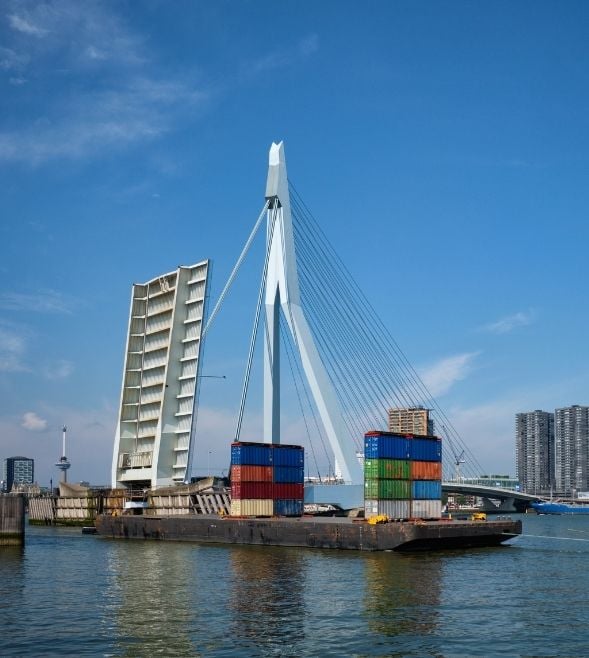-
Financial administration & outsourcing
Entrepreneurs who outsource financial administration reduce the number of administrative tasks and consequently have more time and space to focus on growth.
-
Financial insight
We help you turn financial data into valuable insights that support you in making well-founded decisions. In-depth analyses of your financial situation will help give you a better idea of where you stand and where the opportunities for growth lie, both in the short and long term.
-
Financial compliance
We make sure your company complies with financial legislation and regulations, with correct financial statements, tax reports and other obligations. From our global network, we support you in managing local and international tax risks.
-
Impact House by Grant Thornton
Building sustainability and social impact. That sounds good. But how do you go about it in the complex world of stakeholders, regulations and frameworks and changing demands from clients and society? How do you deal with important issues such as climate change and biodiversity loss?
-
Business risk services
Minimize risk, maximize predictability, and execution Good insights help you look further ahead and adapt faster. Whether you require outsourced or co-procured internal audit services and expertise to address a specific technology, cyber or regulatory challenge, we provide a turnkey and reliable solution.
-
Cyber risk services
What should I be doing first if my data has been kidnapped? Have I taken the right precautions for protecting my data or am I putting too much effort into just one of the risks? And how do I quickly detect intruders on my network? Good questions! We help you to answer these questions.
-
Deal advisory
What will the net proceeds be after the sale? How do I optimise the selling price of my business or the price of one of my business activities?
-
Forensic & integrity services
Do you require a fact finding investigation to help assess irregularities? Is it necessary to ascertain facts for litigation purposes?
-
Valuations
Independent and objective valuations tailored for mergers, acquisitions, and legal matters.
-
Auditing of annual accounts
You are answerable to others, such as shareholders and other stakeholders, with regard to your financial affairs. Financial information must therefore be reliable. What is more, you want to know how far you are progressing towards achieving your goals and what risks may apply.
-
IFRS services
Financial reporting in accordance with IFRS is a complex matter. Nowadays, an increasing number of international companies are becoming aware of the rules. But how do you apply them in practice?
-
ISAE & SOC Reporting
Our ISAE & SOC Reporting services provide independent and objective reports on the design, implementation and operational effectiveness of controls at service organizations.
-
International corporate tax
The Netherlands’ tax regime is highly dynamic. Rules and the administrative courts raise new challenges in fiscal considerations on a nearly daily basis, both nationally and internationally.
-
VAT advice
VAT is an exceptionally thorny issue, especially in major national and international activities. Filing cross-border returns, registering or making payments requires specialised knowledge. It is crucial to keep that knowledge up-to-date in order to respond to the dynamics of national and international legislation and regulation.
-
Customs
Importing/exporting goods to or from the European Union involves navigating complicated customs formalities. Failure to comply with these requirements usually results in delays. In addition, an excessively high rate of taxation or customs valuation for imports can cost you money.
-
Innovation & grants
Anyone who runs their own business sets themselves apart from the rest. Anyone who dares stick their neck out distinguishes themselves even more. That can be rather lucrative.
-
Tax technology
Driven by tax technology, we help you with your (most important) tax risks. Identify and manage your risks and become in control!
-
Transfer pricing
The increased attention for transfer pricing places greater demands on the internal organisation and on reporting.
-
Sustainable tax
In this rapidly changing world, it is increasingly important to consider environmental impact (in accordance with ESG), instead of limiting considerations to financial incentives. Multinational companies should review and potentially reconsider their tax strategy due to the constantly evolving social standards
-
Pillar Two
On 1 January 2024 the European Union will introduce a new tax law named “Pillar Two”. These new regulations will be applicable to groups with a turnover of more than EUR 750 million.
-
Cryptocurrency and digital assets
In the past decade, the utilization of blockchain and its adoption of a distributed ledger have proven their capacity to revolutionize the financial sector, inspiring numerous initiatives from businesses and entrepreneurs.
-
Streamlined Global Compliance
Large corporations with a presence in multiple jurisdictions face a number of compliance challenges. Not least of these are the varied and complex reporting and compliance requirements imposed by different countries. To overcome these challenges, Grant Thornton provides a solution to streamline the global compliance process by centralizing the delivery approach.
-
Private wealth services
Our Private Wealth specialists offer strategic and practical solutions. From tax advice to estate planning and financial scenarios, we make sure you make the right choices today, for tomorrow.
-
Corporate Law
From the general terms and conditions to the legal strategy, these matters need to be watertight. This provides assurance, and therefore peace of mind and room for growth. We will be pro-active and pragmatic in thinking along with you. We always like to look ahead and go the extra mile.
-
Employment Law
What obligations do you have with an employee on sick leave? How do you go about a reorganisation? As an entrepreneur, you want clear answers and practical solutions to your employment law questions. At Grant Thornton, we are there for you with clear advice, from contracts and terms of employment to complex matters such as dismissal or reorganisation.
-
Sustainable legal
At Grant Thornton, we help companies integrate sustainability into their business operations, with sustainable legal at the heart of our approach. We advise on ESG (Environmental, Social, Governance) legislation, and help draft sustainable contracts, implement HR policies, and carry out ESG due diligence in M&A transactions (Mergers and Acquisitions).
-
Pension advisory services
Are you, as business owner or employer, well prepared in terms of pension and other future facilities?
-
Global mobility services
How can you build and evolve a smart global mobility strategy, with policies and processes addressing the complex challenges of managing an international workforce?
-
Maritime sector
How can you continue to be a global leader? The Netherlands depends on innovation. It is our high-quality knowledge which leads the maritime sector to be of world class.

ViDA can be divided in the three main areas:
-
Digital reporting (DRR) based on e-invoicing
Following our preceding general article about VIDA, this article gives a more detailed overview of the proposed changes in the area of the DRR based on e-invoicing and briefly comments on the impact of them for businesses. More details about other areas can be found by clicking on a relevant link above.
Changes in e-invoicing from 2025
From early 2025 (20 days from the adoption of ViDA that is expected in March 2025) no derogation is required for domestic e-invoicing requirements. After adoption of the ViDA, MSs are not required to ask for an agreement from the European Commission to implement e-invoicing requirements for domestic transactions (provided it applies only to established taxpayers). MSs should allow e-invoices that comply with the European standard on e-invoicing (EN 16931) adopted by the Commission Implementing Decision (EU) 2017/187055 and the Directive 2014/55/EU in the context of the B2G e-invoicing (the ‘European standard’). MSs have the option to introduce mandatory e-invoicing for domestic B2B and B2C transactions (for established businesses) without the need for a derogation from the European Commission. This could leave businesses with minimal time to prepare.
Changes in e-invoicing from 1 July 2030
New rules for e-invoicing
- E-invoices will not be subject to the acceptance of the recipient.
- E-invoicing will be the default system for the issuance of invoices.
- A new definition of e-invoices will be introduced.
An ‘e-invoice’ will mean an invoice that contains the required information and which has been issued, transmitted, and received in a structured electronic format that allows for its automatic and electronic processing.
Common system for EU e-invoicing from 1 july 2030
The obligations
There will be an obligation to issue structured e-invoices and to transmit data from these invoices to the relevant national VAT authorities’ electronic portal, in real-time.
Businesses will be obliged to:
- issue structured e-invoices including all required data in standard format within 10 days from a chargeable event; and
- transmit data from these invoices to the relevant national VAT authority’s electronic portal in real time.
While the supplier should report data of the sale when the e-invoice is issued or should be issued, the recipient should report the transaction within 5 days.
Scope
The proposed EU DRR system (e-invoicing and digital transaction-based reporting (DTBR) would not only apply to all intra-Community supplies and acquisitions of goods and services, but also to all business-to-business (B2B) supplies of goods and services that are taxed in a MS other than that in which the supplier is established. The mandatory reverse charge would become mandatory to all B2B transactions by non-established suppliers from 1 July 2028 (see more details in a separate article “ViDA (2) – extension of OSS”. The transactions which will be subject to this extended mandatory reverse charge will also be part of the e-invoicing and DTBR.
More specifically, the EU DRR (e-invoicing and DTBR) would cover:
- intra-Community supplies of goods,
- ‘general’ B2B services rendered between taxpayers established in different MSs,
- supplies of other services subject to the mandatory reverse charge, and
- supplies of goods subject to the mandatory reverse charge.
E-invoicing
Following new data elements should be included on e-invoices:
- mandatory payment details (the identifier of the bank account in which the payment for the invoice will be credited).
- in the case of an invoice that corrects the initial invoice, the corrected/initial invoice’s sequential number.
The possibility to issue summary invoices (covering multiple supplies made during the same calendar month) will only be allowed under certain conditions and should be issued within 10 days.
Digital transaction-based reporting (DTBR)
From 1 July 2030, the European Sales Lists (and Purchase Lists which are obligatory in a few MSs) will be abolished and replaced with the DTBR.
The DTBR for intra-EU transactions will cover the same transactions that were covered by the European Sales Lists (ESLs) with the exception of the reporting of call-off stock transfers falling under EU simplifications which will cease to exist. In addition, supplies of goods and services subject to the extended mandatory reverse charge will be included in the ESLs from 1 July 2028 and in the DTBR from 1 July 2030.
The data containing most of the mandatory VAT invoice details would need to be transmitted on a transaction-level.
The data contained in the e-invoices should be transmitted to tax authorities immediately after the issuance of the e-invoice, or after the date the invoice should have been issued in case the business has not complied with their obligation to issue an e-invoice. The transmission of the data has to be carried out electronically, and MSs will provide the means for that transmission. Finally, the information can be submitted directly by the taxable person or by a third party on their behalf.
The transmission of the data can be done according to the European Standard. MSs can provide for the transmission of the data from e-invoices issued under a different format, as long as they also allow the use of the European Standard.
Reporting purchases of goods and services taking place in the EU
The person acquiring the goods and the recipient of the services will be required to report the data on their intra-Community transactions within 5 days. Businesses will be obliged to transmit the e-invoice data on their intra-Community acquisitions of goods and services as well as on their acquisitions of the goods or services subject to the mandatory reverse charge. The purpose is to compare the data declared by the supplier with the data declared by the customer to detect VAT fraud.
The current VIES will be replaced by the Central VIES system
The Central VIES will be able to store data transmitted on cross-border operations, cross check information received on intra-EU supplies and acquisitions, aggregate data to make it available to national tax authorities by a VAT registration number, and augment the data from the intra-EU transaction reports with other data sources like the customs surveillance system or the future Central Electronic System of Payment information (CESOP). In addition to its reporting uses, the Central VIES system would also contain up-to-date taxpayer’s VAT registration data provided by the national tax authorities’ databases.
Harmonization of the domestic DRRs
From 1 July 2030, the domestic DDRs (if made use of) should comply with the harmonized EU system for DDR (e.g., near-real-time reporting of data on a transaction-by-transaction basis) and the possibility to transmit the data according to the European Standard should be provided.
Member States which already have domestic DRRs will have to adapt them to the features of the EU DDR system by 2035 at the latest.




